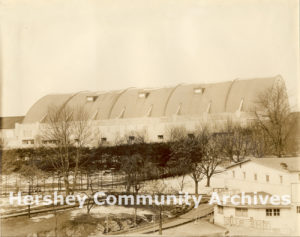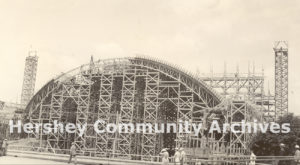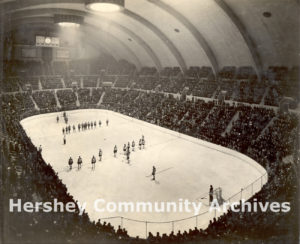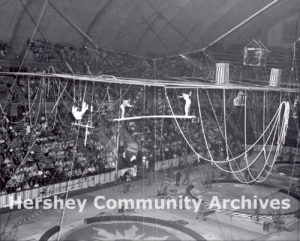Hershey Sports Arena

Hershey Sports Arena is a testament to Milton Hershey’s love of risk-taking and for innovative ideas. Its engineering significance and the story of its construction are a fascinating part of Hershey’s history.
Residents of Hershey have been enthusiasts of hockey for years. Its popularity in its early years brought large crowds to the old Ice Palace. On several occasions hundreds of people were turned away due to lack of space. By 1936 it became apparent to Milton Hershey that a new structure was needed to accommodate the demand for hockey.
Designing the Structure
Mr. Hershey had D. Paul Witmer, manager of the Hershey Lumber Company, solicit plans for a new, larger building. Through a contact with the Portland Cement Company, Witmer was put in touch with Anton Tedesko, a German engineer with the Chicago design-construction firm Roberts and Schaefer. Tedesko was the design engineer who developed the concept of thin shelled concrete structures. He had come to the United States in 1932 to drum up new business for this newly patented construction method. The Arena project offered Tedesko a chance to design the largest monolithic concrete roof structure in North America. There was no precedent for such a structure, no design codes, and no established construction practices for a project of this scale requiring such careful tolerances. On January 21, 1936, Tedesko presented his idea for a huge arena to Paul Witmer, who in turn presented it to Mr. Hershey. Milton Hershey was initially skeptical about the practicality of such a structure. However, the design’s innovation and newness excited him and he soon gave his approval. Tedesko quickly began work on design plans and ground was broken on March 11, 1936.
The Sports Arena is composed of a barrel vault roof, then known as the Zeiss-Dywidag or Z-D type. The concrete shell is only 3.5 inches thick at the upper most part, and is stiffened at 39 foot intervals by massive two-hinged arch ribs. The roof crown is 100 feet above the floor, and the shell was constructed as five separate units, with expansion joints between each unit.
Under Construction
Tedesko realized that the Hershey project would be like no other. He referred to it as a “home-made structure, constructed by Hershey men.” Tedesko became the planner/architect/engineer/construction manager. Milton Hershey wanted to save money and refused to formally hire a construction manager. The result was a rather chaotic beginning. Eventually, Tedesko secured the help of Oscar Spancake, a carpenter-foreman, who mobilized a crew of 250 men, 4 concrete mixers and 2 elevators. The workers had no previous experience in concrete construction, leaving Tedesko no choice but to supervise all aspects of the concrete pours. Remarkably, by July 2, 1936, pouring for the first roof section began.
Formwork for the sections was made up of a patchwork of standard lumber sizes, since Milton Hershey had stipulated that all the lumber associated with the project later be used in the construction of barns and homes in Hershey. The scaffolding structure was composed of over 300,000 board feet of yellow pine lumber. The pours were simultaneously started on both sides from the ground level, and didn’t stop until the two sides came together at the top of the arena. These pours took anywhere from 14 to 20 days, working 24 hours a day.
After the pour was complete the concrete forms were lowered slightly so that the concrete could begin to carry its own weight. After a minimal time of curing, the plan was to lower the support jacks and the forms would drop away from the concrete shell. The first time this step was taken, Witmer feared that the structure was about to collapse. As they lowered the support jacks the concrete continued to stay attached to the forms for the first 2 inches. Much to his relief, the concrete shell stopped settling and separated from the scaffolding as the forms were lowered further.
As the work progressed, the workers gained skill and subsequent sections were completed more efficiently. Pours were still being made when the temperature dropped significantly. To protect the uncured concrete Witmer collected all the horse and cow manure that he could find in the area and had it packed around the concrete to keep it from freezing.
When it opened on December 19, 1936, the Hershey Arena was the first large scale barrel shell roof structure in the United States. Its construction established Anton Tedesko as the preeminent engineer for such structures.
Home for Hockey and More
Since it opened the Arena has been used for a variety of entertainment. As the home ice for the Hershey Bears AHL hockey team until 2002, the Arena hosted countless hockey games, not only for the Bears but also for many junior hockey teams. The Arena also hosted many AHL Calder Cup championship games, including the Bears championship seasons of 1947, 1958, 1959, 1969, 1974, 1980, 1988 and 1997.
The Arena enabled Hershey Park to extend the entertainment season in Hershey, providing an enclosed space for a variety of sporting and performance events. Over the years the Arena served as the venue for tennis matches (Bobby Riggs v. Bill Tilden), ice skating competitions and basketball games. The Arena’s most famous basketball game was held on March 2, 1962, when the Philadelphia Warriors played the New York Knickerbockers. During this game, Wilt Chamberlain scored 100 points, a record that still stands.
Ice skating shows, such as the Ice Capades, Ice Follies, Disney World on Ice and Stars on Ice, all made Hershey Arena an annual stop.
The Arena also hosted other performances such as Ringling Brothers Barnum and Bailey Circus, the Harlem Globetrotters and a variety of musical performers, such as Reba McIntire, Ted Nugent and Liberace.
The Arena quickly became an important part of the Hershey community and served as much more than a sports venue. As the venue with the largest amount of seating, community events were often held here. Community birthday parties for Milton Hershey were held at the Arena in 1937 and 1938. During the 1950s Employee Christmas parties were celebrated at the Arena.
The Arena was also the host for a number of national events. In 1953, the National Republican Committee selected Hershey Arena as the site to celebrate President Dwight D. Eisenhower’s birthday. That same year the Hershey Figure Skating Club hosted the National Figure Skating competition at the Arena. Closer to home, the Arena served as an evacuation site when the region was threatened with a malfunction and partial meltdown of the nuclear core at Three Mile Island in April 1979. Until the situation stabilized, 186 people lived at the Arena for 3 days.
Today the Arena is still an important part of Hershey’s extensive recreational facilities, hosting college hockey, youth hockey and occasional Hershey Bears’ hockey practices. A new sports facility, the Hershey Giant Center opened in 2002. The Giant Center, with expanded seating, luxury boxes and greatly improved team facilities, now serves as home ice for the Hershey Bears and hosts an extensive program of entertainment to the public.
With thanks to Edmond P. Saliklis, Professor of Engineering, California Polytechnic State University


